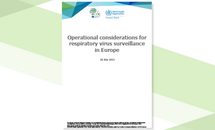Operational considerations for respiratory virus surveillance in Europe
This document outlines operational considerations to support the continuity of national surveillance systems and public health laboratories for epidemiological and virological surveillance for influenza, SARS-CoV-2, and potentially other respiratory viruses (such as RSV or new viruses of public health concern) in the 2022/2023 winter season and beyond. It builds on previously published documents on COVID-19 and influenza surveillance.
Executive summary
Key messages
- The European Centre for Disease Prevention and Control (ECDC), the World Health Organization (WHO) Regional Office for Europe, and the European surveillance networks for COVID-19 and influenza agree on the urgent need to develop and sustain resilient population- based integrated surveillance systems for influenza, COVID-19, and potentially other respiratory virus infections (such as RSV or new viral diseases of public health concern) in Europe.
- Effective integrated respiratory surveillance systems should provide data sufficient for monitoring the spread and intensity of respiratory viruses to guide control measures and mitigate their impact. These systems will also be important in the event of future pandemics.
- Well-designed, representative sentinel surveillance systems in primary and secondary care should remain the central surveillance method for acute respiratory infections. Sentinel systems provide robust epidemiological data that are routinely collected using common syndromic case definitions with reliable denominators and integral microbiological testing that can be extended to multiple viruses. This makes them ideal as the basis of integrated impact assessment of influenza, COVID-19, and potentially other respiratory virus infections.
- Monitoring systems should provide accurate national and regional level estimates of indicators of severity such as hospitalisations, admissions to ICU, and mortality.
- At the same time, these systems should be sensitive enough to detect virus variants, accurately follow virus-specific disease incidence by level of severity/age/place and to assess vaccine effectiveness.
- Strategic prioritisation and sustained financing are required to further expand and develop sentinel systems to make them fit for purpose. Countries should aim to enhance the number and representativeness of sentinel sites and increase the number of tests performed, informed by the considerations for sizing surveillance systems in this document.
- Countries should plan for a potential upscaling of testing for influenza viruses and SARS-CoV-2 if required in response to the emergence of a new SARS-CoV-2 variant of concern or influenza variant.
- The acute respiratory infection (ARI) case definition can be used for primary care sentinel integrated respiratory surveillance, with the benefit that it is more sensitive than the influenza- like illness (ILI) case definition and will result in a much larger number of cases presenting to the sentinel system. Countries that choose to extend to ARI are strongly encouraged to continue to collect the number of consultations from ILI patients, to allow the use of the more specific ILI syndromic indicator for monitoring influenza activity and calculation of epidemic thresholds with historical data.
- Data on COVID-19-specific hospital and ICU admissions and occupancy reported by many countries during the pandemic should continue to be collected and expanded where possible to influenza.
- It is essential to continue reporting epidemiological information from patients with respiratory symptoms testing positive for influenza viruses, SARS-CoV-2 and other relevant respiratory viruses in non-sentinel primary or secondary care laboratories and registry-based systems, including information on where the specimens were obtained. These data will be used to complement data from sentinel systems, particularly while sustainable sentinel systems are being expanded.
- Specimens from patients with respiratory symptoms should be tested using multiplex PCR assays to simultaneously detect influenza viruses, SARS-CoV-2 and other relevant respiratory viruses where possible.
- Genomic monitoring should be integrated within overall respiratory virus monitoring strategies to ensure reliability and interpretability of findings.
- Where possible, all specimens from primary and secondary care sentinel surveillance testing positive for influenza viruses or SARS-CoV-2 should be sequenced. A carefully selected sample (balanced across age groups, geography, and clinical spectrum, including primary and secondary care settings) of influenza virus- and SARS-CoV-2-positive specimens from non- sentinel and registry-based systems should also be sequenced to achieve desired sequencing volumes. The number of sequences required and the relative contribution of sentinel and non- sentinel specimens should be informed by the considerations for sizing surveillance systems presented in this document.
- A subset of specimens from sentinel and non-sentinel sources should be shared for further virus characterisation and antiviral/therapy resistance testing at National Influenza Centres (NIC), SARS-CoV-2 reference laboratories, and/or WHO reference laboratories.
- Specimens testing positive for influenza viruses and SARS-CoV-2 from specific population groups and settings (targeted surveillance) should be sequenced for the purpose of detecting signals of emergence of novel virus variants with potentially changed characteristics, and as a minimum, a subset sent to the NICs, SARS-CoV-2 reference laboratories, and/or WHO reference laboratories for further characterisation.
- Consensus sequences for SARS-CoV-2 and influenza viruses should be deposited in the GISAID database. If available, raw data of SARS-CoV-2 sequences should be deposited in the COVID-19 data portal through the European Nucleotide Archive (ENA).
- Year-round data collection and reporting to The European Surveillance System (TESSy) from sentinel and non-sentinel systems should be maintained in order to be able to identify upsurges and outbreaks during the summer months.
- During the 2022/23 winter season, there will be considerable disparity in the level of implementation of integrated respiratory surveillance among countries in the European region. Data should therefore be interpreted with caution and due consideration of the differences between, and limitations of, the underlying surveillance systems.
Download

Operational considerations for respiratory virus surveillance in Europe - EN - [PDF-2.26 MB]







